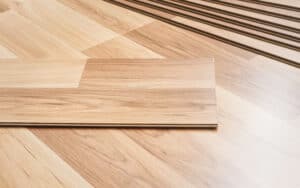
Sometimes you need to drill into a stud to hang a heavy item like a television or a cabinet on a wall.
If you don’t drill into the stud, you may have trouble getting your piece to hang on the wall properly, or to stay there.
Unfortunately, it can be difficult to drill into a stud at times.
There are usually some basic reasons that cause this.
If you are looking to fix the issues with drilling into your stud and getting stuck, we have some solutions you can utilize.
Can’t Drill into Stud (6 Methods To Use)
1. Charge Your Drill

One of the most common reasons for not being able to drill through a stud is the fact that you are using a battery-operated drill that is not charged properly.
Professional contractors will tell you that a battery-operated drill is not going to have as much power as a power drill that is connected to an outlet.
The reason is that the battery-operated drill does not have consistent power for very long.
The battery has peak power for a few minutes, and then the power starts to get lower as soon as the drill is used.
This means that, unless the drill is able to make major progress on the stud quickly, you will have a hard time getting through the stud.
Charging your drill is the best possible way to get the power back in it.
However, you have to accept the fact that a battery-operated drill is likely not going to have nearly as much power as an electric drill.
Therefore, if you are having trouble getting into the stud, it may just be time to change to a different drill.
Also, consider the fact that your battery may be older and ready for a replacement.
Batteries have a lifespan, and when they reach the end of it, they won’t charge to a full capacity.
If your battery-operated drill is several years old, it simply may be time to replace the drill and move on to something a bit more suitable for drilling through studs.
If that’s not a possibility at the moment, charge your drill and try to use it again when the battery has completed a full charge cycle.
This could be all that you need to start being able to drill through studs again.
2. Use a Power Drill, Not Battery-Operated

As we mentioned, a battery-operated drill will be much less powerful than a power drill.
If you are really having a hard time getting this to work, you are going to need to switch to something that has a bit more power.
You can also look at the drill that you purchase and see if the drill itself has enough horsepower to drill through certain objects.
Typically speaking, something with lower horsepower is going to have a hard time getting through a metal stud.
Although some studs are relatively thin, it still takes a good deal of power to drill through them.
Our first two methods have dealt with the fact that your drill is potentially not the right match.
Before you completely decide to change your drill and go with a different method, you may first want to try to look at some of the other methods in case it is not your drill that is causing the issue.
Investigating other issues first is going to help make sure you don’t purchase a drill unnecessarily.
3. Use a Metal Stud Punch

A metal stud punch is a tool that is going to leave a mark in the stud that will allow a screw to be able to penetrate the stud.
When you use a metal stud punch, you will likely end up with a slightly larger hole in your wall.
This makes the metal stud punch a tool for the job of hanging larger things on the wall, but it’s not great for a simple picture frame.
You will need to make sure that the stud punch goes through the wall far enough in to make an indentation in the stud.
Once it has the hole there, the drill could have an easier time getting through the stud and being able to go all the way through.
The stud punch is used just to start the hole in the stud, so it does not necessarily have to go all the way through.
The stud punch is a good tool to have around as it is quick to use, sharp, and effective.
There are other situations where you may find it to be helpful.
Purchasing a stud punch and using it to help you before you decide to buy a brand-new drill is probably a smart choice.
4. Hole Saw

If you are really having trouble with any of the drills that you own, you may have an easier time switching to something like a hole saw.
A hole saw is a good choice if you are trying to hang a large bracket in the wall or even to run wires through a wall.
You have to remember that, with a saw like this, you are probably going to need to put a fairly sizeable patch over the hole in the wall.
Hole saws tend to be quite powerful, and they will normally have an easier time getting through a stud than a little cordless drill.
Be careful using the hole saw, as you will have to know that there is nothing else behind the wall that you could be hitting.
We will go over the different safety precautions that you must take when you use a hole saw to make sure that you don’t cause more harmful issues in your home.
Essentially, you must make sure that you watch out for both electrical and plumbing related fixtures in the wall.
5. Try a Different Drill Bit
Potentially one of the simplest methods for fixing an issue with drilling through a stud is to switch to a different drill bit.
Not all drill bits are cut out for going through a steel stud.
The wrong bit can mean that you will have a hard time getting it through the stud, and it can also just make the bit become dull without anything actually happening.
Most drill bits are going to be able to get through a stud.
If, however, you are using the wrong drill bit, make sure that you are still creating the hole in the stud that you need.
The wrong bit can end up leaving a rough hole in the stud that ends up being detrimental to the screw that you eventually want to put through the stud.
Just make sure you have thought about the type and size of the bit that you are going to use prior to actually starting to drill.
This is one of the only ways to make sure that you are going to get through the stud properly.
If you want to make sure that you get through the stud on the first drill, the cobalt, titanium, or carbide tipped twist bits will provide the best results.
With the proper drill, these bits will get through a stud with ease and leave you a very clean hole in the wall in which to insert your screw.
6. May Not Be a Stud

Last, there is the idea that whatever you are trying to drill through may not actually be a stud.
If this is the case, you may have done some damage.
There are other things inside the walls of our homes that are not studs.
If you drill into something like a pipe or even a brick support beam, you will have to make sure that you have not caused any kind of damage.
This is partially why the preparation part of drilling into studs is just as important as drilling into a stud.
Making sure that you take safety precautions to not do any extra damage is essential.
Precautions Before Drilling into a Wall

As we mentioned, sometimes, you are not able to drill into the wall because there is something else behind the wall.
This brings up some safety issues with improper drilling and making sure that you are following all the necessary steps before drilling.
Here are a few things to think about prior to starting to drill into a stud in your home.
1. Wires
One of the most dangerous things about drilling into the walls is that you might hit a wire.
If the electricity is on in your home and you end up hitting a wire, you risk the chance of an electrical shock.
These types of shocks are sometimes enough to cause serious injury or even death.
Once you hit this wire, if you are fine, you will then need to start working on making sure that the wire gets fixed.
This will include the help of an electrician, and your costs will increase considerably.
Instead of drilling into a wall without thinking, try to assess which wires will likely be running behind the wall that you are working on.
If you see an electrical outlet or a switch nearby, chances are there are some wires around, and you need to be careful.
2. Pipes
Pipes are another major concern when you are drilling into a wall.
Drilling into a water pipe is probably not quite as dangerous as drilling into an electrical wire, but it will be a mess.
If you hit a big pipe that is pressurized, you could end up seeing a large amount of water flow into your home within a very short period of time.
You will have to find the main water valve and turn it off as soon as you can.
Sometimes it can be hard to tell where the pipes are because there are no outlets to help you look.
There are also gas pipes behind the walls that you have to watch out for.
Although it is sometimes impossible to tell if there is a pipe in a specific spot, you can be sure that there will be plenty around the kitchen and bathroom, so be careful in those areas.
3. Use a Stud Finder
A stud finder is one of the best ways to make sure that you drill directly into the stud and nothing else.
One of the things to be sure of is that, when you are using your stud finder, don’t wait for it to notify you and then start drilling.
Run your stud finder along the wall and make sure that it is working correctly.
You should notice that studs are evenly placed across your walls.
There should be some kind of a pattern to the beeping from the stud finder.
This helps to ensure that the unit is actually notifying you to where the studs are and not just beeping for no reason.
The stud finder is a great tool when it is working correctly, but there are times that it will malfunction with a low battery or lower power.
This can cause issues and make it more difficult for you to find the studs.
The bottom line is not to rely completely on the stud finder, but instead, to use it as a backup tool as a way to help you.
4. Weight of Object vs. Hole Size
When drilling into a wall to find a stud, you need to consider the size of the hole you are making and whether or not it is the right size for the task at hand.
If you are trying to hang a 500-pound mirror on your wall, you will need to be very careful about the size of the hole you will need to drill in the wall.
It may take a bit of math and common sense to make sure that you don’t cause extra damage when you are changing things in your home.
The studs are a great way to make sure that you have more stability.
Certainly, drilling and securing into a stud is better than the drywall or plaster, but it still needs to be done the right way to avoid any major issues.
The last thing you want to do is walk away from your project and notice that the wall is not actually going to hold things up.
This will cause quite a bit of damage as you see your previous artwork or your brand-new cabinet starts to slide down or fall off the wall, and that’s a terrible thing.
Avoid all of this by handling this project the right way from the start.
Conclusion
Hopefully, you now have a better understanding as to why your stud drilling project did not work out.
Drilling into studs is not difficult as long as you have the proper equipment.
The equipment needs to be high-powered and fast in order to get the materials to drill through the stud properly.
As you can imagine, the process is made more dangerous when you look at the issues with plumbing and electrical in the wall.
Always evaluate the situation before you just start drilling, and you will be glad you took the necessary precautions.
With a bit of thinking and careful planning, you should have no issues drilling through a stud.




Leave a Reply